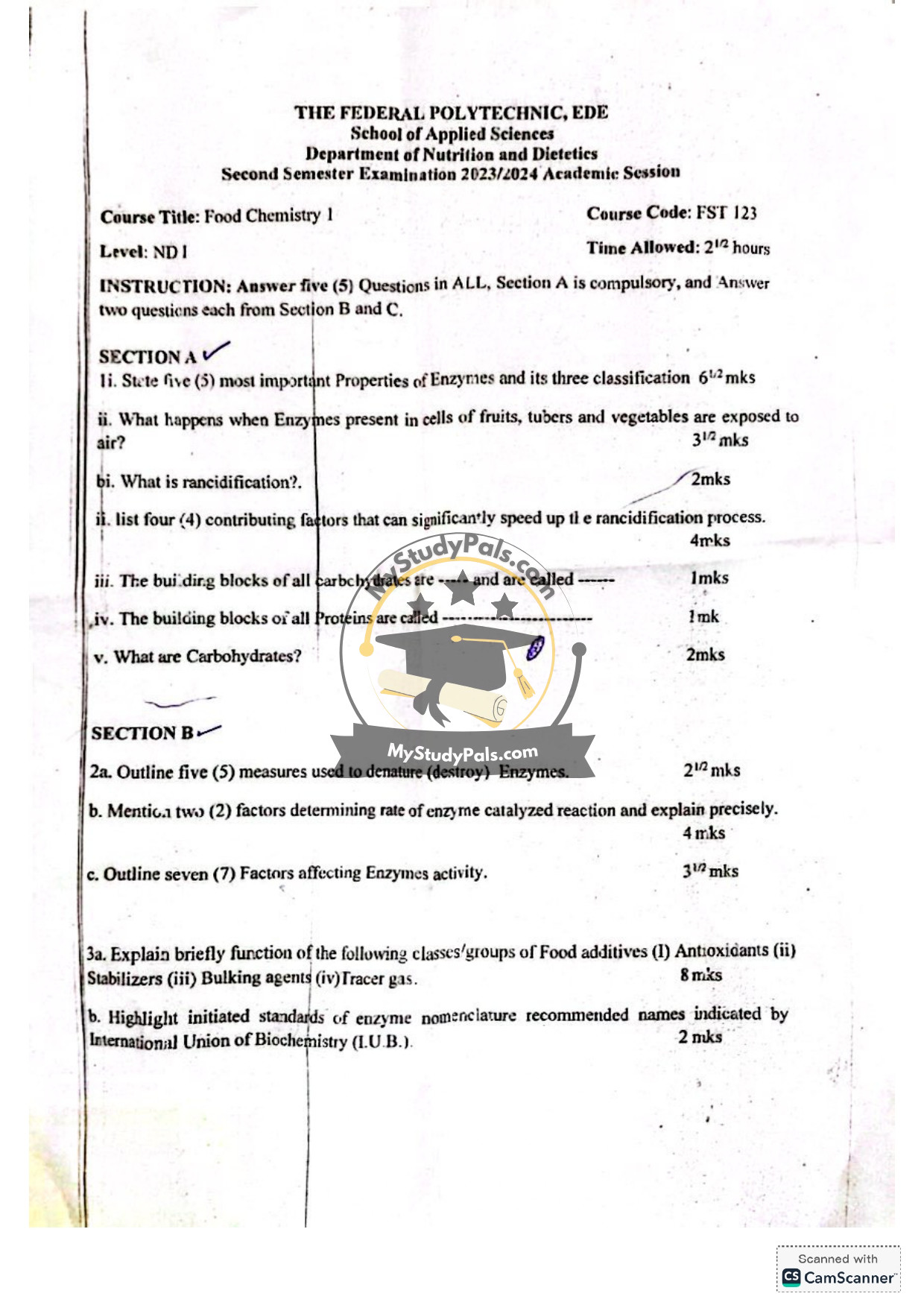ANWSER
Question 1 (i): State five (5) most important Properties of Enzymes and its three classifications.
Answer:
Properties of Enzymes:
1. Enzymes are biological catalysts that speed up chemical reactions without being consumed.
2. They are highly specific, acting on particular substrates.
3. Enzymes are sensitive to temperature and pH changes.
4. They work optimally under mild conditions (e.g., body temperature).
5. Enzymes can be regulated (activated or inhibited) by other molecules.
Classifications of Enzymes:
1. Oxidoreductases – Catalyze oxidation-reduction reactions.
2. Hydrolases – Catalyze hydrolysis reactions (breaking bonds with water).
3. Lyases – Catalyze the removal or addition of groups to form double bonds.
—
Question 1 (ii): What happens when Enzymes present in cells of fruits, tubers, and vegetables are exposed to air?
Answer:
When enzymes in fruits, tubers, and vegetables are exposed to air, oxidation occurs, leading to enzymatic browning. This reaction, catalyzed by enzymes like polyphenol oxidase (PPO), causes discoloration, loss of flavor, and reduced nutritional quality.
—
Question 1 (bi): What is rancidification?
Answer:
Rancidification is the chemical decomposition of fats and oils, resulting in unpleasant odors and flavors due to oxidation or hydrolysis.
—
Question 1 (bii): List four (4) contributing factors that can significantly speed up the rancidification process.
Answer:
1. Exposure to oxygen (oxidation).
2. High temperatures.
3. Presence of light (UV radiation).
4. Moisture (hydrolytic rancidity).
—
Question 1 (biii): The building blocks of all carbohydrates are — and are called —.
Answer:
The building blocks of all carbohydrates are monosaccharides and are called simple sugars.
—
Question 1 (biv): The building blocks of all Proteins are called —.
Answer:
The building blocks of all proteins are called amino acids.
—
Question 1 (bv): What are Carbohydrates?
Answer:
Carbohydrates are organic compounds composed of carbon, hydrogen, and oxygen, serving as a primary energy source. They include sugars, starches, and fibers, classified as monosaccharides, disaccharides, and polysaccharides.
—
Question 2a: Outline five (5) measures used to denature (destroy) Enzymes.
Answer:
1. Heat treatment (e.g., blanching, pasteurization).
2. Extreme pH levels (acidic or alkaline conditions).
3. Heavy metals (e.g., mercury, lead).
4. Organic solvents (e.g., alcohol, acetone).
5. Oxidizing agents (e.g., hydrogen peroxide).
—
Question 2b: Mention two (2) factors determining the rate of enzyme-catalyzed reactions and explain precisely.
Answer:
1. Temperature – Enzymes have an optimal temperature; too high denatures them, while too low slows activity.
2. Substrate concentration – Reaction rate increases with substrate concentration until all active sites are saturated.
—
Question 2c: Outline seven (7) Factors affecting Enzymes activity.
Answer:
1. Temperature
2. pH level
3. Substrate concentration
4. Enzyme concentration
5. Presence of inhibitors
6. Presence of activators/cofactors
7. Ionic strength
—
Question 3a: Explain briefly the function of the following classes/groups of Food additives.
Answer:
1. Antioxidants – Prevent oxidation, extending shelf life (e.g., vitamin E, BHA).
2. Stabilizers – Maintain texture and prevent separation (e.g., pectin in jams).
3. Bulking agents – Add volume without calories (e.g., cellulose).
4. Tracer gas – Used in packaging to preserve freshness (e.g., nitrogen in chips).
—
Question 3b: Highlight initiated standards of enzyme nomenclature recommended names indicated by International Union of Biochemistry (I.U.B.).
Answer:
The I.U.B. standardizes enzyme names based on reaction type, using:
– Systematic names (describe the reaction, e.g., “ATP:glucose phosphotransferase”).
– Recommended names (simpler, e.g., “hexokinase”).
– EC numbers (classification codes, e.g., EC 2.7.1.1).


